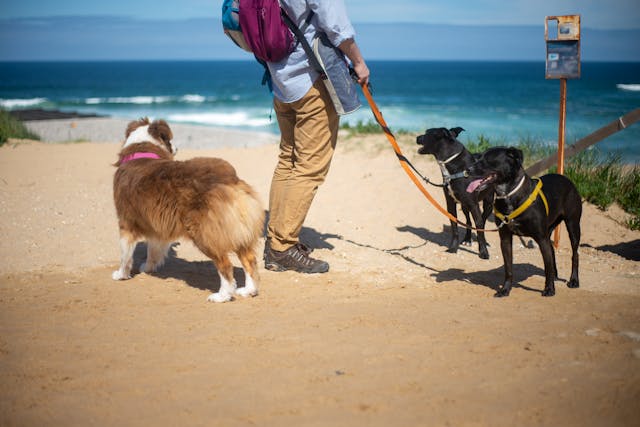If you have a female dog that hasn’t been spayed, she will go into heat multiple times throughout her life. This natural reproductive cycle can be a challenging time for both the dog and the owner. Knowing how to properly care for a dog in heat can make the process easier, ensuring her safety and comfort. In this guide, we will cover the essential dos and don’ts to help you navigate this period with confidence.

Understanding the Heat Cycle in Dogs
A dog’s heat cycle, also known as estrus, occurs every 6 to 12 months, depending on the breed. The cycle lasts about 2-4 weeks and consists of four stages:
- Proestrus (7-10 days): Swollen vulva, bloody discharge, increased male attraction, but she won’t allow mating.
- Estrus (5-14 days): Ovulation occurs, and she is receptive to males.
- Diestrus (60-90 days): Either pregnancy occurs or hormone levels return to normal.
- Anestrus (4-5 months): A resting phase before the next cycle begins.
Recognizing these stages helps in providing the best care possible.
The Dos of Caring for a Dog in Heat
1. Keep Your Dog Indoors and Supervised
When a dog is in heat, male dogs can detect her scent from miles away. Always keep her indoors, or if she must go outside, ensure she’s in a securely fenced area and supervised at all times.
2. Use Doggy Diapers
To manage the bleeding, consider using disposable or washable dog diapers. This helps maintain cleanliness in your home and prevents unwanted messes on furniture and carpets.
3. Maintain Good Hygiene
Clean her bedding and any areas where she rests frequently. You may also gently wipe her vulva area with pet-safe wipes to keep her comfortable and odor-free.
4. Provide Extra Comfort and Attention
Dogs in heat may experience mood swings, anxiety, or clinginess. Offer her extra cuddles, soothing words, and favorite toys to keep her comfortable.
5. Adjust Her Exercise Routine
Regular exercise is still essential but modify her routine to ensure safety. Take her on walks during off-peak hours and keep her on a leash at all times to avoid any unwanted attention from male dogs.
6. Offer a Safe and Quiet Space
A female dog in heat may prefer a quiet retreat. Provide a comfortable, stress-free space where she can rest away from household noise and activity.
7. Monitor Her Health
Look for signs of distress, excessive bleeding, or unusual behavior. If she seems lethargic, refuses to eat, or shows signs of discomfort, consult a veterinarian.
The Don’ts of Caring for a Dog in Heat
1. Don’t Leave Her Unsupervised Outdoors
Even if your yard is fenced, determined male dogs can find ways to get in. Always accompany her when she’s outside.
2. Don’t Take Her to Dog Parks or Public Spaces
Avoid taking her to places where other dogs are present. Male dogs will be drawn to her, increasing the risk of accidental mating and potential aggression.
3. Don’t Punish Her for Mood Swings or Accidents
Hormonal changes can cause behavioral shifts. If she has an accident inside or becomes more anxious, respond with patience and kindness rather than punishment.
4. Don’t Bathe Her Too Frequently
While hygiene is important, excessive bathing can dry out her skin and cause irritation. Stick to gentle cleaning with wipes or occasional lukewarm baths if necessary.
5. Don’t Ignore Signs of Health Issues
If she has excessive bleeding, foul-smelling discharge, or prolonged lethargy, these could be signs of infection or other health concerns. Seek veterinary advice immediately.
6. Don’t Allow Unplanned Mating
If you’re not planning to breed your dog, prevent contact with male dogs to avoid unwanted pregnancies. Spaying is the best long-term solution if you don’t intend to breed her.
7. Don’t Overwhelm Her with Stimulation
Your dog may be more irritable or anxious during this time. Avoid introducing new experiences, meeting too many people, or taking her to loud environments.
When to Consider Spaying
Spaying (surgical removal of the ovaries and uterus) is a highly recommended option for pet owners who do not intend to breed their dogs. It eliminates heat cycles and offers health benefits such as reducing the risk of mammary tumors and uterine infections. Consult with your vet about the best time to spay your dog.
FAQs About Caring for a Dog in Heat
1. How long does a dog stay in heat?
A dog’s heat cycle lasts around 2-4 weeks, with the most fertile period occurring between the second and third weeks.
2. How can I stop my dog from bleeding everywhere?
Doggy diapers or absorbent pads can help manage bleeding and keep your home clean. Frequent cleaning of bedding and designated resting areas is also recommended.
3. Can I walk my dog while she is in heat?
Yes, but always keep her on a leash and avoid areas with other dogs, particularly male dogs, to prevent unwanted mating attempts.
4. Should I spay my dog before or after her first heat?
Most vets recommend spaying before the first heat cycle, as it significantly reduces the risk of certain cancers and reproductive diseases. However, consult with your veterinarian for the best timing.
5. Do female dogs experience pain during heat?
Dogs may experience mild discomfort or cramping, but they usually do not show signs of severe pain. If your dog seems excessively uncomfortable, consult a vet.
6. Can a dog get pregnant at any time during heat?
A dog is most fertile during the estrus stage, typically between days 10-14 of the heat cycle. However, pregnancy can occur at other times during the cycle as well.
7. What happens if my dog accidentally mates while in heat?
If accidental mating occurs, consult a veterinarian as soon as possible. They can discuss options, including pregnancy prevention or monitoring.
8. Is it normal for my dog to behave differently during heat?
Yes, dogs in heat may become more affectionate, anxious, or irritable due to hormonal changes.
Final Thoughts
Caring for a dog in heat requires patience, awareness, and proactive measures. By following the dos and avoiding the don’ts, you can ensure a stress-free experience for both you and your furry friend. Whether you decide to manage her heat cycles naturally or opt for spaying, providing a loving and safe environment is key to her well-being.

